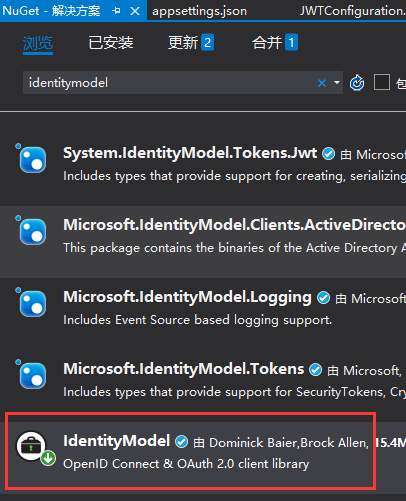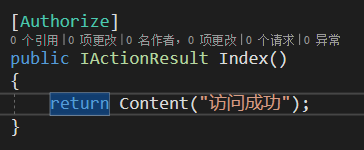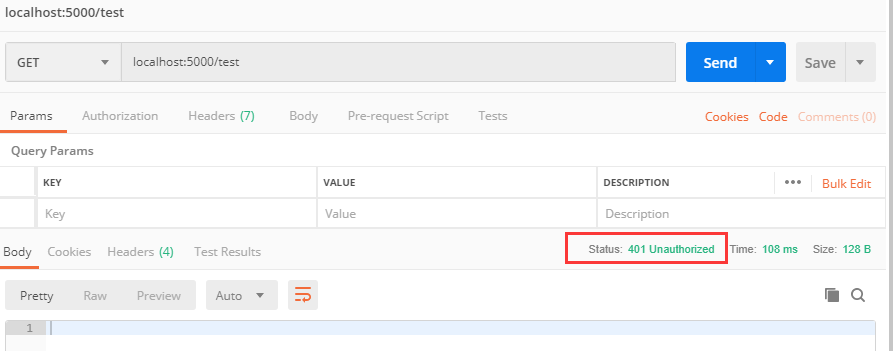因为害怕token泄露出现问题,所以从未在项目中使用jwt。但这玩意现在真的很火,趁有空还是研究了一下。
在aspnetcore中实现jwt很简单,感觉微软把很多工作都做了,虽然开发效率上去了,但是使得c#的程序员变得很傻,很多事情都是知其然而不知其所以然,只能绑死在微软这条大船上越行越远,唉~~
jwt一般在webapi的项目使用比较多,但我下面的代码都是在MVC环境上测试的,用法上应该没什么区别。
一、添加和配置JWT
1、引入nuget包
VS中点击 工具 > 管理解决方案 NuGet 程序包,搜索 IdentityModel,安装到项目

2、添加JWT配置项
打开 appsettings.json ,添加节点
"Authentication": { "JwtBearer": { "IsEnabled": "true", "SecurityKey": "JWTStudyWebsite_DI20DXU3", "Issuer": "JWTStudy", "Audience": "JWTStudyWebsite" } }
3、新建 JWTConfiguration.cs 文件,内容如下:
using Microsoft.Extensions.Configuration; using Microsoft.Extensions.DependencyInjection; using Microsoft.IdentityModel.Tokens; using System; using System.Text; namespace JWTStudent.Website.Extensions { public static class JwtConfiguration { public static void AddJwtConfiguration(this IServiceCollection services, IConfiguration configuration) { if (bool.Parse(configuration["Authentication:JwtBearer:IsEnabled"])) { services.AddAuthentication(options => { options.DefaultAuthenticateScheme = "JwtBearer"; options.DefaultChallengeScheme = "JwtBearer"; }).AddJwtBearer("JwtBearer", options => { options.Audience = configuration["Authentication:JwtBearer:Audience"]; options.TokenValidationParameters = new TokenValidationParameters { // The signing key must match! ValidateIssuerSigningKey = true, IssuerSigningKey = new SymmetricSecurityKey( Encoding.ASCII.GetBytes(configuration["Authentication:JwtBearer:SecurityKey"])), // Validate the JWT Issuer (iss) claim ValidateIssuer = true, ValidIssuer = configuration["Authentication:JwtBearer:Issuer"], // Validate the JWT Audience (aud) claim ValidateAudience = true, ValidAudience = configuration["Authentication:JwtBearer:Audience"], // Validate the token expiry ValidateLifetime = true, // If you want to allow a certain amount of clock drift, set that here ClockSkew = TimeSpan.Zero }; }); } } } }
4、在StartUp.cs的ConfigurationServices方法内,添加如下代码:
services.AddJwtConfiguration(Configuration);
二、创建AccessTokenController,用于申请和发放JWT
public IActionResult Post([FromBody]LoginModel model) { var user = TempData.Users.FirstOrDefault(m => m.Account == model.Account && m.Pw == model.Pw); if (user != null) { var claims = new[] { new Claim(ClaimTypes.Name, user.Account), new Claim(ClaimTypes.Role, user.Role) }; var key = new SymmetricSecurityKey( Encoding.UTF8.GetBytes(_configuration["Authentication:JwtBearer:SecurityKey"])); var credentials = new SigningCredentials(key, SecurityAlgorithms.HmacSha256); var token = new JwtSecurityToken( _configuration["Authentication:JwtBearer:Issuer"], _configuration["Authentication:JwtBearer:Audience"], claims, expires: DateTime.Now.AddMinutes(30), signingCredentials: credentials ); return Ok(new AccessTokenResult {Token = new JwtSecurityTokenHandler().WriteToken(token), Code = 200}); } return Ok(new AccessTokenResult {Code = 0, Token = ""}); }
LoginModel是自定义的登录模型,很简单,仅包含用户名和密码两个字段。AccessTokenResult是自定义的返回结果,int类型的Code,登录成功则返回200,失败为0,Token是生成的JWT
三、测试
1、创建TestController,并为其添加 Authorization 描述

2、运行程序,打开Postman,访问 http://localhost:5000/test

不出所料,访问被拒绝,提示没有授权。
3、获取JWT
访问 http://localhost:5000/api/accesstoken

4、使用Token重新访问受限的Action
拷贝token的值,重新请求 http://localhost:5000/test,在Headers上添加一项,KEY 为 Authorization,VALUE 为 Bear+空格+token值
